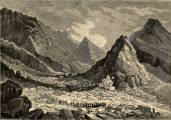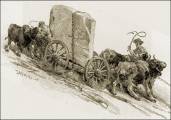


"Sixteenth Annual Report of the United States Geological
Survey,
Part IV.-Mineral Resources of the United States, 1894,
Nonmetallic Products."
Excerpts from the chapter on "Stone"
by William C. Day.
( Click here
if you wish to read the entire chapter on "Stone.")
Regarding the
State of Kentucky Stone Industry in the Mid-1890s.
The Kentucky Sandstone Industry in the Mid-1890s
Kentucky.-Although sandstone has been quarried in seven counties of the State, almost nothing was done in 1894. Productive counties are Rowan, Muhlenberg, Lewis, Bell, Crittenden, Rockcastle, and Ohio.
The Kentucky Limestone Industry in the Mid-1890s
Kentucky.-Limestone to the value of $113,934 was quarried in Kentucky in 1894. The productive counties are Warren, Jefferson, Kenton, Fayette, Pendleton, Lyon, Jessamine, Menifee, Logan, Montgomery, Caldwell, Crittendon, Boyd, Marion, Hardin, Washington, Carter, and Trigg.
The product of Warren is deserving of special notice because of its peculiarities and its value as a building stone. This stone is known commercially as Bowling Green oolite. It is quite different from the oolitic stone of Indiana, inasmuch as it belongs to another limestone group, the constituent globules being large and distinct, whereas in most of the Indiana stone they are minute. It is quite similar to the Portland oolite of Ireland. The following analyses of Bowling Green and Portland oolite show the similarity between the two:
|
Composition of Bowling Green, Ky., limestone compared with Portland, Ireland, limestone. |
|||
| Bowling Green | Portland | ||
| Carbonate of lime | 95.31 | 95.16 | |
| Carbonate of Magnesia | 1.12 | 1.20 | |
| Silica | 1.42 | 1.20 | |
| Water and loss | 1.76 | 1.94 | |
| Iron and alumina | .39 | .50 | |
| Total | 100.00 | 100.00 | |
The quarries are of large extent and are well equipped with channeling machines, derricks, etc. A mill with twelve gangs of saws finishes the stone. Blocks of almost any size can be furnished. These quarries were first opened in 1833, but until recently they were operated in the most primitive manner, and while the product has been used chiefly in the South, efforts are now being made to introduce the stone to the building trade in the Northern States. Among the cities in which it has been most used are Louisville, Memphis, Nashville, and Bowling Green; to some extent also in Chicago. The stone is soft and easily worked, and, like the Indiana stone, hardens on exposure to the atmosphere. Carvings made upon the stone stand exposure to the air very well. Its color, under the influence of sunlight, tends to become continually lighter. Its crushing strength is such as to enable it to resist a pressure of 3,000 pounds to the square inch. When heated to redness on the surface and plunged into cold water it revealed no crack, even upon examination with a magnifying glass, and in some cases on being reheated for a second and third time and plunged into water, still failed to present indications of cracking. According to present indications the extended application of the stone in the northern and eastern portions of the country seem highly probably.
Commercial use of material within this site is strictly prohibited. It is not to be captured, reworked, and placed inside another web site ©. All rights reserved. Peggy B. and George (Pat) Perazzo.